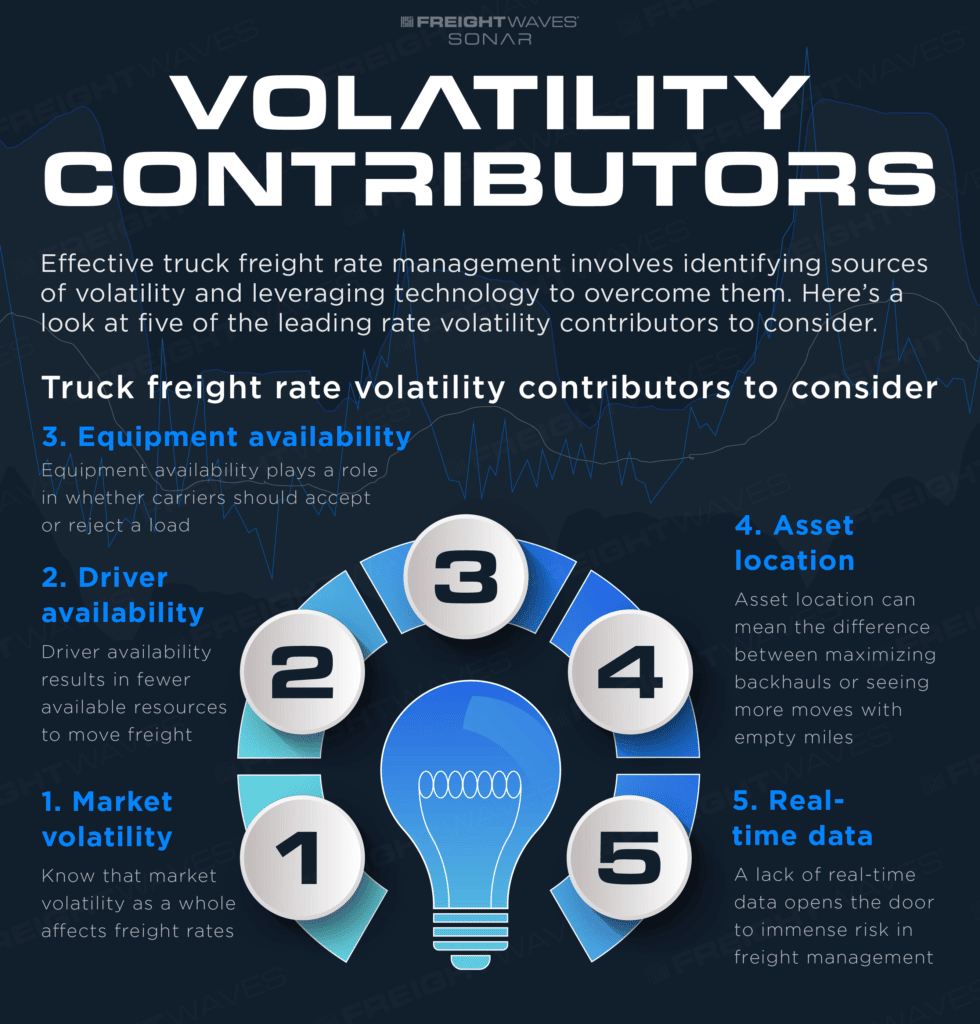(Graphics created by Emily Ricks)
There are many attributes to consider when considering a truck freight rate. This is particularly important to weigh because of the impacts that freight rates have on the entire industry. After all, the freight market is incredibly complex and continuously evolving to meet the demands of e-commerce and order fulfillment. Freight managers need to take a few considerations into account with all decisions. And these fluctuations within the trucking market range from market volatility to the lack of real-time data. For that reason, let’s take a closer look at five of the leading rate volatility contributors to consider.
Market volatility is important to consider because of its direct effect on the freight industry. This is essentially a risk assessment within the market. Higher volatility amounts to a higher risk. And it also presents the opportunity to make more money by aligning freight rates accordingly as well. The truck freight rate is directly affected by how the market is responding to outside factors, such as increased port or e-commerce activity. And this can be particularly challenging in 2021 considering the pandemic and the state of the shipping world.
Driver availability is yet another factor to consider when calculating and planning for changes within the truck freight rate. Unfortunately, the U.S. trucking industry is experiencing a shortage of drivers. This will increase the truck freight rate. Why? Because fewer truck drivers mean overworked, tired drivers. Also, fewer drivers limit available capacity, and since less capacity for freight amounts to added delays in shipping, Jim Beach of TruckingInfo, wrote that carriers will charge more for their drivers. It’s that simple principle that affects all carrier operations.
Another issue to consider in rate management goes back to equipment availability. One thing to keep in mind is that not all trucks are equipped to handle each load. And some may lack liftgates or other basic equipment that’s standard within white-glove logistics. That’s why it’s critical to understand and know what is necessary for each shipment when quoting or booking a load. Freight consolidation and optimization are particularly important during this time, as a lack of equipment will amount to a missed delivery.
Asset location also poses its own unique set of challenges to the truck freight rate. Asset-based freight companies help shippers and brokerages find drivers and capacity when times are tough. While convenient, their asset-based nature also drives up cost by introducing higher overhead expenses, including truck insurance costs, benefits and more. Considering the idea is to drive down costs and optimize freight rates to maximize profitability per load or to keep rates as low as possible, depending on whether a shipper or carrier is looking at the process, a lack of insight into real-time location poses a stark threat. For instance, lack of data could lead to more deadheading, eating away at profitability, but again more data can help carriers stay strategic.
Real-time data is crucial to the optimization of the truck freight rate. The lack of real-time data leaves the driver and the carrier in the dark through the freight and shipping processes. Without data, rates are skewed and based on assumption. And as the recent years have taught life-long industry professionals, freight management can turn on a dime. Also, real-time data is beneficial when determining the proper and more efficient route, giving insight into how companies can lower their operating costs and expand their base of customers – such as enterprise shippers. Consider what Jim Beach also had to say about the value of real-time visibility and data. “Real-time visibility of their shipments means they are aware of problems sooner, allowing them to take action sooner. Schedules can be adjusted; loading docks can handle a truck that is already there instead of holding a dock open for a truck that’s going to be three hours late.” Ultimately, not having access to real-time data can drive costs up, and drivers lose wages.

Each of the issues listed above factor into truck freight rate volatility. Carriers and transportation experts must be aware of how optimization depends on the ability to navigate these circumstances. Analytics is an important part of continuing to stay competitive within the industry and greatly reduces the probability of severe volatility for the truck freight rate. Request a FreightWaves SONAR demo by clicking the button below to get started.
